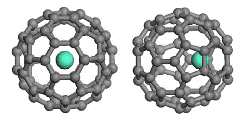Chemistry, Department of: Faculty Series

Xiao Cheng Zeng Publications
Document Type
Article
Date of this Version
2-20-2008
Abstract
We perform total energy calculations on a manganese atom encapsulated inside a C60 cage using density functional theory with the generalized gradient approximation through three optimization schemes and along four paths inside the cage. We find that when Mn is located in the central region, its electronic and magnetic properties are not exactly the same as those of a free Mn atom due to weak coupling between Mn and the cage. As Mn is shifted toward to the edge, the total energy and spin start to change significantly when Mn is situated about one-third of the way between the cage center and edge, and the total energy reaches a local minimum. Finally the interaction between Mn and the cage turns repulsive as Mn approaches the edge. We also find that, along the lowest energy path, there exist three consecutive local energy minima and each of these has a different spin M. The ground state has the lowest M=3, Mn is located about 1.6 Å away from the cage center, and the binding energy is 0.08 eV. We attribute the decrease in total energy and spin to Mn and C hybridization.


Comments
Published in THE JOURNAL OF CHEMICAL PHYSICS 128, 074304 (2008). Copyright © 2008 American Institute of Physics. Used by permission.